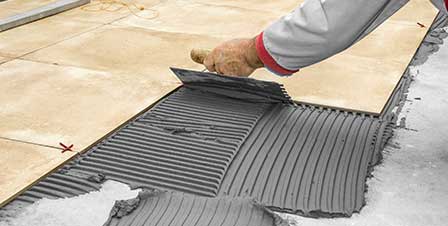Change Your Home with Professional Tile Installation Austin
Wiki Article
Discover the Keys to Perfect Ceramic Tile Installation Whenever
Accomplishing perfect floor tile installation may seem like a complicated task, frequently resulting in irritation and blemishes that diminish the overall visual. Mastering the art of ceramic tile installation involves a series of specific actions and strategies that, when executed appropriately, can result in a smooth and refined finish. From surface area prep work to grout application, each stage plays an important function in the last outcome of your project. By recognizing the keys behind each action, you can ensure that your ceramic tile setup not just meets yet surpasses your assumptions.
Correct Surface Area Preparation
Reliable tile installation pivots dramatically on careful surface preparation to ensure a perfect result. The surface should be clean, completely dry, and structurally appear to stop future problems such as loose ceramic tiles or cracked grout.To guarantee proper bond, it is suggested to rough up smooth surfaces with sanding or scarifying. Furthermore, using a guide can improve bonding in between the tile and the substratum adhesive. Uneven surfaces must be leveled using a self-leveling substance to avoid lippage and ensure a smooth coating.
Moreover, inspecting for prospective resources of moisture is vital, as excess wetness can bring about mold development and damage the ceramic tiles over time. Using a dampness barrier or waterproofing membrane layer in damp areas like kitchens or bathrooms is necessary to secure the floor tiles from water damages. By thoroughly preparing the surface area before floor tile installation, one can develop a long lasting and aesthetically appealing tiled location that will stand the test of time.

Picking the Right Adhesive
Selecting the appropriate adhesive is a vital action in making sure the effective setup of ceramic tiles. The type of adhesive you pick will certainly depend upon different factors such as the sort of floor tile, the substrate material, and the area of the installment. There are various types of adhesives available on the market, including thin-set mortar, mastic, and epoxy.
Epoxy adhesives are exceptionally sturdy and waterproof, making them suitable for locations susceptible to moisture such as cooking areas or washrooms. They are also appropriate for setting up glass or steel floor tiles. When picking a glue, make certain to follow the supplier's referrals and consider the specific needs of your tile installment task.
Accuracy Cutting Strategies
One of the most common devices made visit homepage use of for accuracy cutting in tile setup is the tile cutter. Ceramic tile cutters come in various kinds, including manual floor tile cutters, electrical damp saws, and handheld tile cutters. Hands-on tile cutters are appropriate for straight cuts on ceramic and porcelain floor tiles, offering tidy and precise edges.In addition, using a tile nipper enables thorough cuts and forming around obstacles or uneven forms. Wet ceramic tile saws furnished with ruby blades are outstanding for making curved cuts, intermediaries for fixtures, or detailed styles. Furthermore, making use of tools like floor tile scribes or glass cutters can assist in racking up and snapping tiles with accuracy. By mastering these accuracy cutting techniques, ceramic tile installers can ensure an expert surface and a visually enticing cause their ceramic tile tasks.

Cement Application Tips
When transitioning from accuracy reducing techniques to grout application in ceramic tile setup, interest to detail and useful source strategy is critical for attaining a flawless surface. Grout serves not just as a useful aspect that fills up the gaps in between floor tiles however also plays a significant role in the overall visual of the setup.Once the grout is applied, make use of a moist sponge to cleanse the tiles, making certain not to get rid of cement from the joints. Adhering to these grout application pointers will certainly result in a professionally set up ceramic tile surface area that improves the elegance of any space.
Finishing Touches and Maintenance
To finish the floor tile setup task efficiently, focus to information throughout the completing touches and routine maintenance is essential. After the cement has dried out and the ceramic tiles are firmly in area, the final actions entail making certain that all sides are correctly sealed.Routine maintenance is key to preserving the beauty and functionality of your tiled surfaces. A straightforward regimen of sweeping or vacuuming followed by mopping with a mild cleaner see here can help maintain your ceramic tiles looking immaculate (tile installation austin). For locations that are regularly exposed to wetness, such as kitchens or bathrooms, normal resealing of cement lines is recommended to avoid mold and mold development
Final Thought
To conclude, achieving best floor tile setup every time needs focus to detail and appropriate methods. By focusing on surface prep work, choosing the correct adhesive, using accuracy cutting approaches, using grout carefully, and completed with attention to detail, you can make certain a professional-looking result. Remember to follow these actions and maintain your ceramic tiles frequently to lengthen their lifespan and maintain them looking their ideal.One of the most typical tools utilized for precision cutting in floor tile setup is the tile cutter. Tile cutters come in different types, including manual tile cutters, electrical wet saws, and portable ceramic tile cutters. Hands-on ceramic tile cutters are suitable for straight cuts on ceramic and porcelain ceramic tiles, giving exact and clean sides. Furthermore, utilizing tools like tile scribes or glass cutters can assist in racking up and snapping ceramic tiles with precision. By grasping these accuracy cutting strategies, ceramic tile installers can guarantee a professional finish and an aesthetically appealing result in their ceramic tile tasks.
Report this wiki page